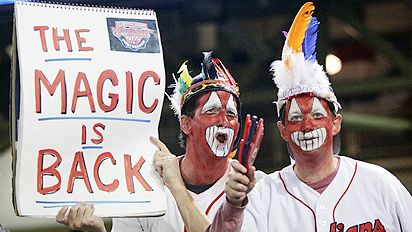100 Years of Insult: Ban the Cleveland Indians Name and Logo
By Michelle Jacobs
Calling Cleveland’s professional baseball team the “Indians” does not only equate American Indian people with ferocious animals in the symbolic realm. It affects the everyday lives of American Indians because stereotypical ideas about Indians, embedded in the culture for hundreds of years, have replaced genuine concerns for the identities, communities, and cultures of American Indian people. The treatment of American Indian protestors outside the Cleveland baseball stadium illustrates this point. Protestors witness first-hand how the purportedly "harmless" team name causes baseball fans to callously disregard the history and humanity of American Indian people. They angrily yell insults like "Go back to where you came from!" and "We won, so get lost!” at protestors. They also don feathers and face paint for entertainment purposes, although these items are sacred to American Indian people. Fans supporting their much adored “Tribe” simultaneously snub their noses at (or flip the bird to) actual Indians struggling to convey a simple message: We are people, not mascots.
By Cynthia Connolly
In a 2012 interview, Bob DiBiasio, Senior Vice President of Public Affairs for the Cleveland Indians commented that fans do not associate the logo with actual Native Americans. He stated, “When people look at our logo, we believe they think baseball.” This is troublesome considering it is impossible to honor a group of people if one does not even think about them. DiBiasio’s statement makes it clear that the mascot is not intended to honor or represent anything; it is simply a brand and marketing tool for Cleveland baseball.
However, Native people cannot afford to serve as the brand for sports teams. Not when in 2010 the Pine Ridge Reservation declared a state of emergency due to unprecedented youth suicide rates. Not when Native women are 2.5 times more likely to be raped. Not when Natives have the highest poverty rate than any other race in this country.
The use of Native mascots generates a great deal of apathy, making it difficult for anyone to take our socio-economic issues seriously when all they know are costume headdresses, the tomahawk chop, and Chief Wahoo. We simply cannot allow America use our name and image whenever and however they choose for their entertainment. Especially when they don’t even think of us. They only think of baseball.

Words plus action
People aren't just analyzing why Chief Wahoo and other mascots are wrong, they're taking action:
Cleveland Councilman Zack Reed says Chief Wahoo is the 'red Sambo,' calls for city to ban logo from public spaces (VIDEO)
By Leila Atassi
During the miscellaneous comments portion of Monday night’s council meeting, Reed said that he has been barraged by emails and phone calls from worldwide associates since the seemingly perennial controversy over Wahoo erupted in the news in recent weeks. The world outside of Cleveland, Reed said, sees Wahoo as an unquestionably racist and demeaning icon.
“(Wahoo supporters) may say that inside Cleveland, 90 percent say ‘keep it,’” Reed said. “But they don’t tell you that outside of our footprint, the vast majority of people believe it should go.”
He said that he remembers when society made the same arguments about Sambo and Jim Crow and other racially denigrating iconography.
But today, after the great sacrifices made in the name of the Civil Rights movement, “no one would dare place an African American caricature on a sports team,” he said.
“So is this as important as homicides?” Johnson said. “Yes. Because it deals with the death of character and the disrespect of a people. Even if they don’t find it insensitive, I do. And that’s why I think it’s time to retire Chief Wahoo.”
Some fans are quietly removing Chief Wahoo logos from apparel they've bought
By Paul Lukas
This is the "de-Chiefing" phenomenon, a form of silent protest by a small but growing number of Indians fans who love their team but are opposed to the Wahoo logo, which they view as an offensive caricature. They say they're not accusing pro-Wahoo fans of being racists or telling them what they should or shouldn't wear. They've simply made a decision not to wear the Chief themselves.
De-Chiefing has been taking place under the radar for at least a few years now, and it's not clear who started it. But the practice first began attracting public attention a few weeks ago, when an Indians fan named Dennis Brown was preparing to visit the team's spring training facility in Goodyear, Ariz., and tweeted a photo showing how he'd removed the Wahoo sleeve patch from his jersey, leaving a Wahoo-shaped scar on the sleeve:

By Mark Naymik
Organizers behind the demonstration have tried to rally people against Wahoo on opening day for more than 20 years, though team owners and baseball fans have generally ignored them. In some years, only a handful of demonstrators have stood with signs against Wahoo.
Organizers hope to find greater support this year because of the renewed attention Wahoo has received in the growing national debate over sports mascots and names sparked by the NFL's Washington Redskins' controversy.
The Plain Dealer editorial board recently called on the Cleveland Indians' owners to drop the smiling, big-toothed, big-nosed cartoon Indian, which has been used for more than 60 years.

No comments:
Post a Comment